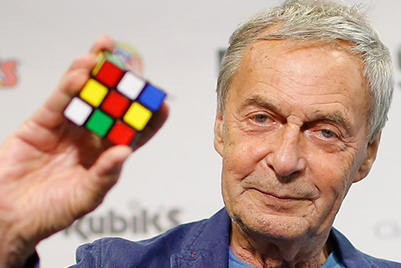Invention begins with seeing familiar things in a new way. What can you learn from the Rubik’s cube and its inventor? Here we take a closer look.
“If you are curious, you’ll find the puzzles around you. If you are determined, you will solve them.”
The Rubik’s Cube has become a world-famous and instantly recognizable toy since its launch over 40 years ago. The toy is iconic as an intellectual challenge that people instantly pick up and start playing around with intuitive understanding of what the end goal (all same color squares on each side) is. This geometric puzzle is easily accessible, does not require written instructions and offers also a sense of order and completion.
In 1974, a 29-year-old Hungarian sculptor and architect Ernõ Rubik invented the Rubik’s Cube, which he initially called the ‘Magic Cube’ or ‘Buvos Kocka’ in Hungarian, as a way of teaching his students how to solve three-dimensional problems. The toy that he made that did not break no matter how much you twisted or turned it. Rubik’s architecture students at the Budapest College of Applied Arts (Iparművészeti Főiskola) loved it.
Image via Rubiks
His toy became very popular in Hungary. The country was Communist at the time, with tight regulations on imports and exports. Rubik shared his invention at toy fairs. At the Nuremberg Toy Fair in 1979, he met Tom Kremer who saw the potential in the toy and wanted to sell it worldwide.
Through Tom’s help, Rubik was able to sell over 100 million cubes of the newly renamed toy, the Rubik’s Cube worldwide. The updated version also was lighter. Soon there were competitions worldwide to see who could solve the Rubik’s Cube puzzle the fastest.
Image via Rubiks
“Space always intrigued me, with its incredibly rich possibilities, space alteration by objects, objects’ transformation in space, movement in space and in time, their correlation, their repercussion on mankind, the relation between man and space, the object and time. I think the CUBE arose from this interest, from this search for expression and through increased acuteness of these thoughts.”
Erno Rubik with his daughter Anna in 1981
Rubik revealed a keen awareness of what people liked and an appreciation for art and form. He also attributed his love of art and science to his parents. His father was a well known mechanical engineer who built gliders while his mother loved language and writing. Rubik initially studied to be a sculptor and then discovered that he had a keen interest and passion for technical applications. He went on to study architecture soon after. He credits the schools and universities that he attended as helping him in practicing his craft and giving him the necessary space and equipment to experiment, research and learn.
Rubik used wood for the blocks and rubber bands and paper clips to hold the pieces together in his first prototype. He used primary colors to help him bring some order to the cube rotations and used stickers on the finished cube. After his students had tested it out and loved it, Rubik found a plastics manufacturer to help him prototype his toy model. It was only after he met Tom Kremer that Rubik was able to build out his cube properly and then share his toy with the world.
“People like its beauty, simplicity and form. It’s really not a puzzle or a toy. It’s a piece of art.”
People Love Order, Though Order is Harder to Achieve than Chaos
The Rubik’s Cube has 43 quintillion (43,252,003,274,489,856,000) possible configurations, with only one correct solution. Despite these odds, the toy itself has a wide appeal. Adults and children alike love to pick it up and attempt to solve the geometric puzzle.
Image via Cube20.org
Strategy can appear magical, when it is just well thought out and precise
Given the odds, solving a Rubik’s cube puzzle especially when someone hands you a random configuration, can seem miraculous. However, there are actual strategies that you can follow to solve this puzzle regardless of what configuration you receive. The key is to create order partially and to build on this since all ‘chaos’ cannot be resolved all at once. Systematically applying complex patterns can seem like magic to those that are unfamiliar, when in actuality, there is a strong logic and mathematical order to the process.
43 quintillion options definitely sounds daunting, but actually solving the Rubik’s cube puzzle follows a logical process of using 15 algorithms. No matter what configuration you receive, you can apply these 15 algorithms and solve the cube puzzle.
Don’t Be Afraid to Start Over and Try Again
Few things make starting over and trying again as appealing as the Rubik’s cube. In fact, the toy invites you to step outside your comfort zone, challenge yourself, think differently and learn something new.
Rubik said that the first time he solved the puzzle it took him weeks. Later on, it would take him roughly one minute. Some people are able to solve the puzzle in under 30 seconds.
The Rubik’s cube also offers a relaxed way to help you build your focus.
Engage Audiences in New Ways
The Rubik’s cube remains incredibly popular today, with contests, social media videos and exhibits such as Beyond Rubik’s Cube by the Liberty Science Center that promotes new ideas based on the cube.
Beyond Rubik’s Cube Exhibit by Liberty Science Center
Read more of our Profiles and learn with us! Have an individual in mind that you would like us to profile? Tell us at hello@elf.agency.





